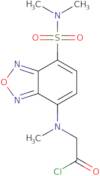DBD-COCl [=4-(N,N-Dimethylaminosulfonyl)-7-(N-chloroformylmethyl-N-methylamino)-2,1,3-benzoxadiazole]
CAS: 156153-43-4
Ref. 3D-GGA15343
| 25mg | Descatalogado | ||
| 50mg | Descatalogado | ||
| 100mg | Descatalogado | ||
| 250mg | Descatalogado | ||
| 500mg | Descatalogado |
Información del producto
- 4-(N-Chloroformylmethyl-N-Methylamino)-7-(N,N-Dimethylsulfamoyl)Benzofurazan
- 4-(N,N-Dimethylaminosulfonyl)-7-(N-Chloroformylmethyl-N-Methylamino)-2,1,3-Benzoxadiazole
- 4-(N,N-Dimethylaminosulfonyl)-7-(N-Chloroformylmethyl-N-Methylamino)Benzofurazan
- 4-(N,N-Dimethylaminosulfonyl)-7-(N-Chloroformylmethyl-N-Methylamino)Benzofurazane
- 4-(N-Chloroformylmethyl-N-Methyl)Amino-7-N,N-Dimethylaminosulfonyl-2,1,3-Benzox
- Adiazole
- N-[7-(N,N-Dimethylsulfamoyl)-4-Benzofurazanyl]Methylamino-Acetyl Chloride
- N-[7-(dimethylsulfamoyl)-2,1,3-benzoxadiazol-4-yl]-N-methylglycyl chloride
DBD-COCl is an enantiomer of a fluorescent derivative of benzoxadiazole. It has been used as a fluorescent probe to study the reaction kinetics of hexane, an organic solvent, with various amides. The fluorescence detector is set in flow mode and the flow rate is adjusted to ensure that the reaction time is short enough to observe the maximum number of fluorescence peaks. This allows for more precise measurements and better resolution. DBD-COCl reacts with metoprolol, which binds to it through its amide group, forming a fluorescent derivative that can be detected by a fluorescence detector.





